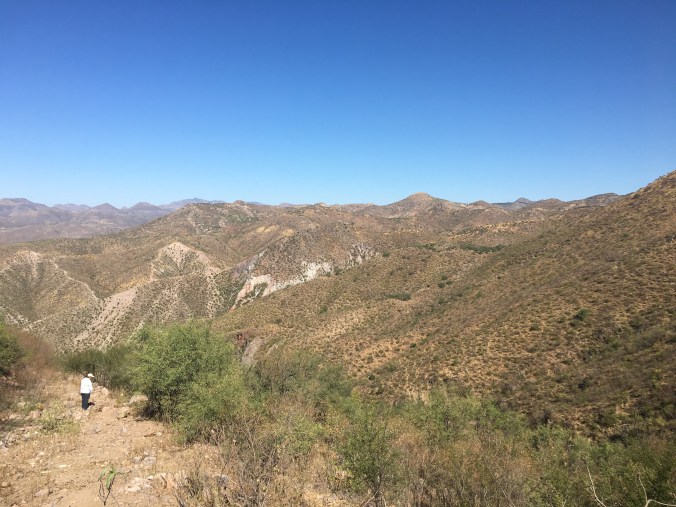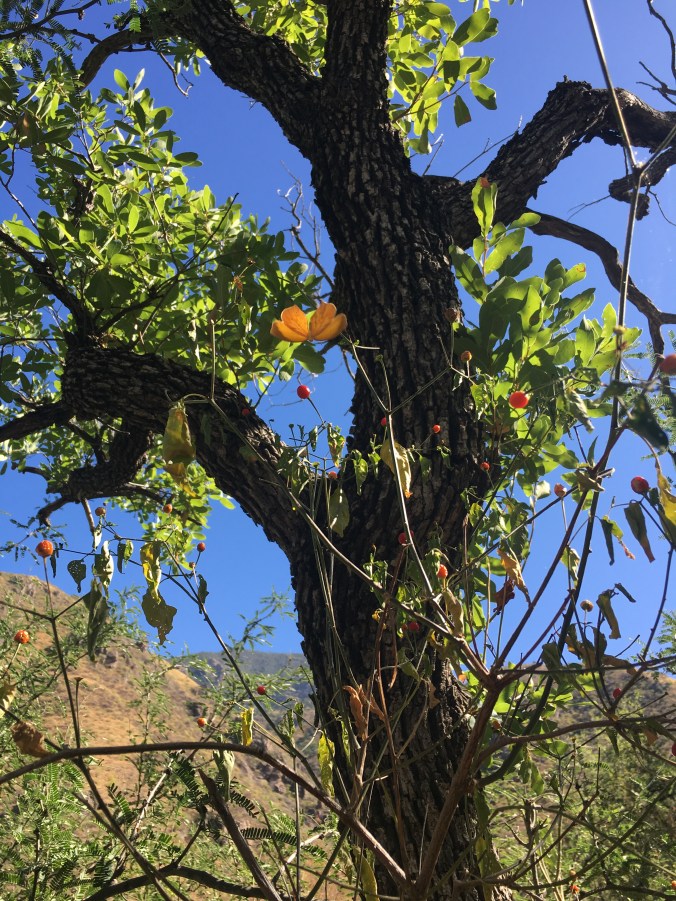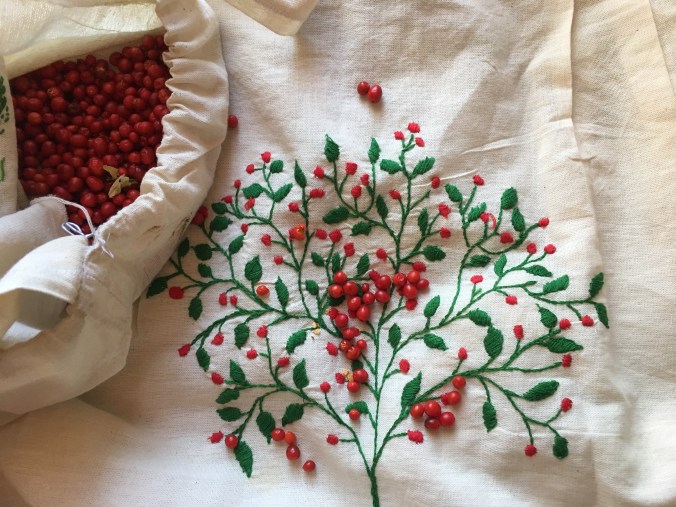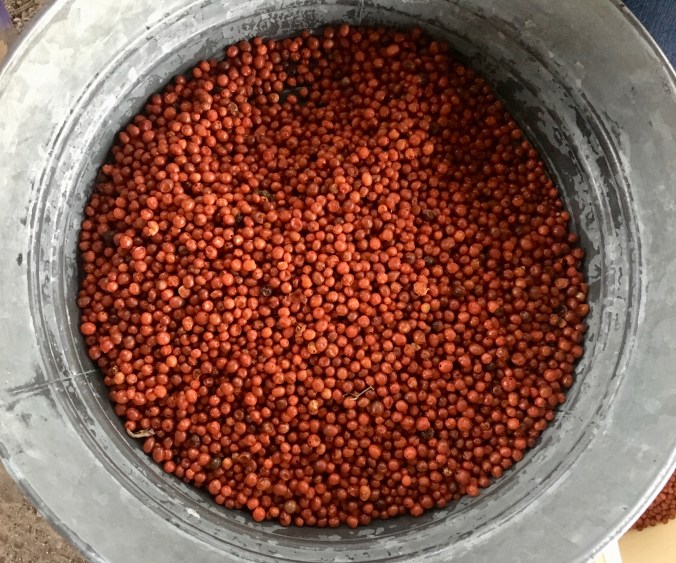Savor Sister Linda here on this 1st day of December in the Old Pueblo – and a cloudy Friday it is! We are on the brink of a full moon; check the sky tomorrow evening as it rises, about 5PM, Tucson time.
I am hoping rain follows these clouds. If you know of a good school on the Practice of Powerful Rain Dances, let me know. The Sonoran Desert is parched. No matter what side of the border you live, or whether you are an animal or vegetable or mineral, it is dry. Dry. Dry.

A friend and Very Dry Land, as we searched for wild chiltepin plants, two weeks ago.
I read a poem this week that won’t let me go. The poem, True North, is by Doug von Koss, I’ll offer you just a few lines in case they speak to you.
“That other compass
you bought in the city
is no good to you now

This wild chiltepin plant is growing in a Plant Guild, under an Oak Tree (and Mesquite; note the legume leaves). It is because of these mutually beneficial, interdependent guild relationships that these plants survive in even tougher than usual conditions. Note the yellow butterfly.
The chiltepin we did pick are even more precious than usual now. In the photo above you can see a wild chile plant growing under an oak, and near a mesquite tree as well. I love these nurse plants so fundamental to the survival of wild chiles. We harvested here about three weeks ago, talking and picking for hours, feet slipping on steep hillsides, as have countless humans for 8000 years. As the rhythm of the picking worked it’s magic on me, I found myself thinking of the Tree of Life.
Anne Baring, author, Thought Leader, and a woman of wonderful integrity, (and her co-author Jules Cashford), in The Myth of the Goddess; Evolution of an Image writes, “The Tree of Life was one of the primary images of the goddess herself, in whose immanent presence all pairs of opposites are reconciled. Growing on the surface of the earth, with roots below and branches above, the tree was the great pillar that united earth with heaven and the underworld, through which the energies of the cosmos poured continuously into earthly creation. The animating spirit that moved within it was the serpent guardian also of the fruit or treasure of the tree, which was the epiphany of the goddess, that is, the experience of unity.” (page 496).
The experience of unity. Not the idea of unity. Not thinking about unity. But experiencing it. Which includes our unity with nature and with our food – so that we might live more as it as if we were an expression of life; and less as it we were isolated from it. When I am picking wild chiles, for example, I feel connected to all the other hands that have picked this tiny chiles for more than 8000 years; I feel reverence for the beaks and tongues of birds who ate/eat and spread it’s seed. I feel happy that I can eat food that is really food. That comes fresh. Not wrapped in plastic; not processed at all.

Chiltepin which in my experience is the most aromatic chile in the world. Not only are they incredibly flavorful, but they smell so darned good!
 No recipe this week; the photos won’t transfer over to this site for some reason, and the recipe needs the pics. Instead, consider eating as if you really really really were a part of our food system. Be the Tree of Life. Because we are all connected, to each other and to our food, it is both wise and fun to bring to our tables and our tongues food that makes a positive impact on Our Tree of Life.
No recipe this week; the photos won’t transfer over to this site for some reason, and the recipe needs the pics. Instead, consider eating as if you really really really were a part of our food system. Be the Tree of Life. Because we are all connected, to each other and to our food, it is both wise and fun to bring to our tables and our tongues food that makes a positive impact on Our Tree of Life.
Farmers markets are a great place to buy food as “close to the source” as is possible, without growing it yourself. If you live here in the South West, you could plant a winter garden. There are few things as satisfying as feeling your own food. If you live in colder climes, flirt with planting some herbs in a pot inside by a window this winter. Or finding a spot to plant a garden in the spring.
Happy Full Moon.



Nice post Linda! I’ve been enjoying chiltepins a lot lately as I just recently stocked up on a few different varieties. I have some experiments going right now and was wondering if you have any experience with fermenting the fresh or dry peppers? I’m hoping to make some sort of probiotic hot sauce and have started a few random chiltepin ferments.
LikeLike
Nate – I LOVE your innovative spirit! I have added them to fermented concoctions, such as kimchi, but have never tried fermenting them “themselves”. PLEASE keep me posted on how your experiments unfold and about what you learn! Where in the country do you do these Culinary Experiments? I would love to see what you are up to first hand! Please stay in touch! And thank you so much for reading our blog!
LikeLike
I have not heard about a chiltepin in many years!
LikeLike
Tony – Thank you so much for reading our blog. I checked yours our and it is gorgeous! Are you the photographer? And when and where did you learn about chiltepines?
LikeLiked by 1 person
Well, I am not exactly a photographer. I just take pictures with a digital camera, and some are taken with the camera on the telephone. I remember chiltepins from an old article about ‘bird peppers’. I am not sure if that is just a pretty name for them or if it is because they grow near trees where birds perch and ‘deposit’ the seed. It was a very long time ago, but I never forgot them. I liked that they are native to Texas, and not some fancy hybrid or well bred variety. I like plants that are as they were naturally in the wild. I also like how it has become such a traditional pepper among those who know it, although I really don’t know what it is used for. I remember reading that some people keep them in tins like chewing tobacco in their back pockets to chew on when they get to craving one.
LikeLike